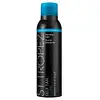What's inside
What's inside
 Key Ingredients
Key Ingredients

 Benefits
Benefits

 Concerns
Concerns

 Ingredients Side-by-side
Ingredients Side-by-side

Dimethyl Ether
SolventWater
Skin ConditioningAlcohol Denat.
AntimicrobialDihydroxyacetone
Skin ConditioningPEG-40 Hydrogenated Castor Oil
EmulsifyingGlycerin
HumectantEthoxydiglycol
HumectantPropylene Glycol
HumectantPhenoxyethanol
PreservativeHydrolyzed Jojoba Esters
Skin ConditioningTocopherol
AntioxidantLinalool
PerfumingHexyl Cinnamal
PerfumingBenzyl Salicylate
PerfumingCaprylyl Glycol
EmollientDecylene Glycol
Skin ConditioningButylphenyl Methylpropional
PerfumingCitronellol
PerfumingLimonene
PerfumingAlpha-Isomethyl Ionone
PerfumingGeraniol
PerfumingCoumarin
PerfumingCI 14700
Cosmetic ColorantCI 19140
Cosmetic ColorantCI 42090
Cosmetic ColorantDimethyl Ether, Water, Alcohol Denat., Dihydroxyacetone, PEG-40 Hydrogenated Castor Oil, Glycerin, Ethoxydiglycol, Propylene Glycol, Phenoxyethanol, Hydrolyzed Jojoba Esters, Tocopherol, Linalool, Hexyl Cinnamal, Benzyl Salicylate, Caprylyl Glycol, Decylene Glycol, Butylphenyl Methylpropional, Citronellol, Limonene, Alpha-Isomethyl Ionone, Geraniol, Coumarin, CI 14700, CI 19140, CI 42090
Water
Skin ConditioningIsoamyl Laurate
EmollientDimethicone
EmollientCI 77400
Cosmetic ColorantHydroxyethyl Acrylate/Sodium Acryloyldimethyl Taurate Copolymer
Emulsion StabilisingGlycerin
HumectantOrbignya Oleifera Seed Oil
EmollientCI 77492
Cosmetic ColorantTheobroma Grandiflorum Seed Butter
Skin ConditioningSorbitan Isostearate
EmulsifyingPolysorbate 60
EmulsifyingSqualane
EmollientTocopherol
AntioxidantSilica
AbrasiveCitric Acid
BufferingSodium Citrate
BufferingPhenoxyethanol
PreservativeBenzyl Alcohol
PerfumingCI 77491
Cosmetic ColorantWater, Isoamyl Laurate, Dimethicone, CI 77400, Hydroxyethyl Acrylate/Sodium Acryloyldimethyl Taurate Copolymer, Glycerin, Orbignya Oleifera Seed Oil, CI 77492, Theobroma Grandiflorum Seed Butter, Sorbitan Isostearate, Polysorbate 60, Squalane, Tocopherol, Silica, Citric Acid, Sodium Citrate, Phenoxyethanol, Benzyl Alcohol, CI 77491
Ingredients Explained
These ingredients are found in both products.
Ingredients higher up in an ingredient list are typically present in a larger amount.
Glycerin is already naturally found in your skin. It helps moisturize and protect your skin.
A study from 2016 found glycerin to be more effective as a humectant than AHAs and hyaluronic acid.
As a humectant, it helps the skin stay hydrated by pulling moisture to your skin. The low molecular weight of glycerin allows it to pull moisture into the deeper layers of your skin.
Hydrated skin improves your skin barrier; Your skin barrier helps protect against irritants and bacteria.
Glycerin has also been found to have antimicrobial and antiviral properties. Due to these properties, glycerin is often used in wound and burn treatments.
In cosmetics, glycerin is usually derived from plants such as soybean or palm. However, it can also be sourced from animals, such as tallow or animal fat.
This ingredient is organic, colorless, odorless, and non-toxic.
Glycerin is the name for this ingredient in American English. British English uses Glycerol/Glycerine.
Learn more about GlycerinPhenoxyethanol is a preservative that has germicide, antimicrobial, and aromatic properties. Studies show that phenoxyethanol can prevent microbial growth. By itself, it has a scent that is similar to that of a rose.
It's often used in formulations along with Caprylyl Glycol to preserve the shelf life of products.
Tocopherol (also known as Vitamin E) is a common antioxidant used to help protect the skin from free-radicals and strengthen the skin barrier. It's also fat soluble - this means our skin is great at absorbing it.
Vitamin E also helps keep your natural skin lipids healthy. Your lipid skin barrier naturally consists of lipids, ceramides, and fatty acids. Vitamin E offers extra protection for your skin’s lipid barrier, keeping your skin healthy and nourished.
Another benefit is a bit of UV protection. Vitamin E helps reduce the damage caused by UVB rays. (It should not replace your sunscreen). Combining it with Vitamin C can decrease sunburned cells and hyperpigmentation after UV exposure.
You might have noticed Vitamin E + C often paired together. This is because it is great at stabilizing Vitamin C. Using the two together helps increase the effectiveness of both ingredients.
There are often claims that Vitamin E can reduce/prevent scarring, but these claims haven't been confirmed by scientific research.
Learn more about TocopherolWater. It's the most common cosmetic ingredient of all. You'll usually see it at the top of ingredient lists, meaning that it makes up the largest part of the product.
So why is it so popular? Water most often acts as a solvent - this means that it helps dissolve other ingredients into the formulation.
You'll also recognize water as that liquid we all need to stay alive. If you see this, drink a glass of water. Stay hydrated!
Learn more about Water